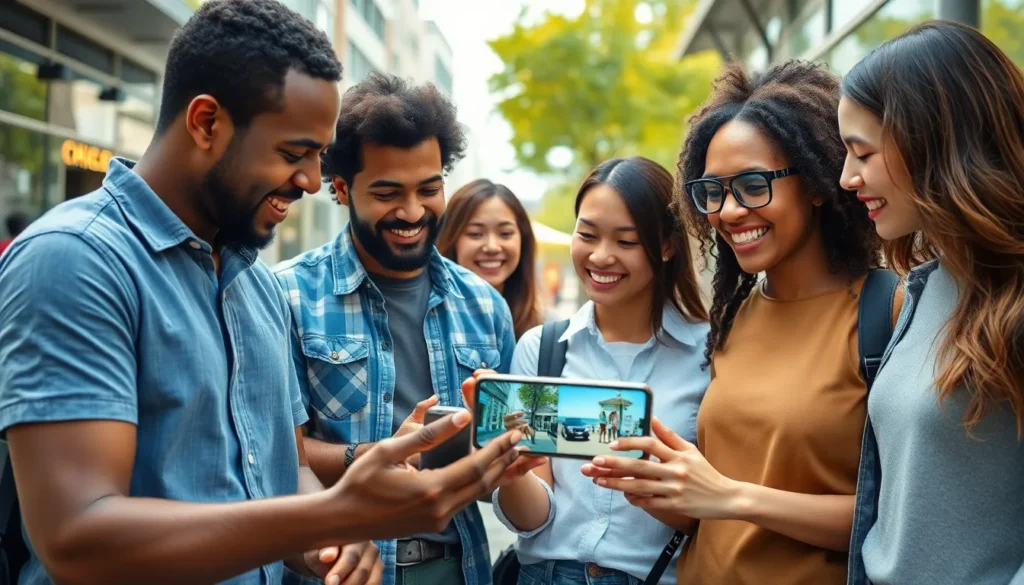Table of Contents
ToggleAugmented Reality (AR) is revolutionizing the way brands connect with their audiences. With its ability to blend digital elements into the real world, AR content marketing offers a unique and immersive experience that captures attention like never before. As consumers increasingly seek interactive and engaging content, businesses are turning to AR to create memorable marketing campaigns that stand out.
This innovative approach not only enhances brand visibility but also fosters deeper customer engagement. By leveraging AR technology, companies can tell compelling stories, showcase products in a dynamic way, and provide personalized experiences that resonate with their target audience. As the digital landscape evolves, understanding the potential of AR content marketing becomes essential for brands looking to stay ahead of the competition.
What Is AR Content Marketing?
AR content marketing utilizes Augmented Reality technology to deliver interactive and immersive experiences to consumers. It integrates digital elements with the real world, enabling brands to showcase products and services in engaging ways.
AR content marketing enhances traditional marketing strategies by offering a unique method for storytelling. Brands create interactive narratives that capture consumer attention and encourage deeper engagement. For instance, customers can visualize how products fit into their lives before making purchases, improving decision-making.
AR content marketing encompasses various formats, including AR ads, interactive packaging, and mobile applications. These experiences often require users to engage through smartphones or AR glasses, allowing dynamic interactions that traditional media cannot achieve.
Benefits of AR content marketing include increased brand visibility, higher engagement rates, and improved customer retention. Studies show that AR experiences can lead to a 70% increase in customer engagement compared to standard content. Brands leveraging AR technology effectively foster emotional connections with consumers, enabling loyalty and repeat business.
As digital landscapes evolve, AR content marketing serves as a vital tool for brands aiming to create memorable customer experiences and remain competitive.
Benefits of AR Content Marketing

AR content marketing offers significant advantages for brands, prominently increasing engagement and empowerment in brand awareness. Implementing AR technology allows businesses to connect more effectively with their audience, fostering memorable experiences.
Enhanced User Engagement
Enhanced user engagement is a key benefit of AR content marketing. AR experiences captivate consumers, leading to higher interaction rates. Studies show that AR content generates a 70% increase in engagement compared to traditional media. Brands can create interactive product demonstrations, allowing consumers to visualize items before purchase. This dynamic interaction not only maintains attention but encourages sharing among users, amplifying brand reach. Features like try-before-you-buy scenarios enable consumers to make informed decisions, enhancing satisfaction.
Improved Brand Awareness
Improved brand awareness results from effective AR content marketing strategies. Brands that utilize AR stand out in crowded markets, captivating consumers with innovative experiences. By incorporating unique AR elements, businesses convey their value propositions more clearly and compellingly. Visual storytelling in AR can communicate a brand’s identity and message, fostering deeper emotional connections with consumers. The integration of AR into marketing campaigns increases visibility across platforms, enhancing recall and recognition. This multifaceted approach helps brands remain relevant in a competitive landscape while attracting new customers.
Strategies for Implementing AR Content Marketing
AR content marketing incorporates innovative strategies that enhance consumer engagement through immersive experiences. By leveraging interactive elements and gamification, brands can create memorable connections with their audience.
Interactive AR Experiences
Interactive AR experiences enable consumers to engage with products in a dynamic way. Brands can create virtual showrooms, allowing users to explore products from different angles and perspectives. By integrating features like 3D visualizations, users can rotate and zoom in on products, enhancing their understanding. For instance, furniture retailers can use AR to let customers visualize how a piece fits in their home environment, increasing confidence in purchasing decisions. Additionally, brands can implement AR-enabled print advertisements, facilitating a digital interaction that enriches the traditional media experience. These engaging formats lead to heightened consumer interest and improved campaign effectiveness.
Gamification Techniques
Gamification techniques amplify the appeal of AR content marketing by adding elements of play. Brands can incorporate challenges, rewards, or virtual badges to motivate user participation. For example, an outdoor apparel brand might develop an AR scavenger hunt, enticing users to find hidden items in their environment using their mobile devices. This approach not only drives brand engagement but also strengthens consumers’ connections to the brand. Research shows that gamified experiences can lead to a 25% increase in interaction times, enhancing overall brand trust and loyalty. By blending entertainment with marketing objectives, brands can make their campaigns more compelling and memorable.
Examples of Successful AR Content Marketing Campaigns
IKEA Place
IKEA revolutionized the furniture shopping experience with its IKEA Place app. This AR application enables customers to visualize furniture in their homes by overlaying 3D models in real time. Users can scale furniture to fit their spaces, enhancing decision-making and reducing purchase hesitation. The app significantly increased online engagement, with studies showing a 70% rise in conversion rates.
L’Oreal’s Makeup Genius
L’Oreal’s Makeup Genius app illustrates how AR transforms beauty marketing. This app allows users to try on makeup products virtually. By leveraging facial recognition technology, customers can experiment with various looks before purchasing. The app’s interactive experience boosted user engagement, driving almost 30% of users to visit physical stores after trying products virtually.
Pepsi Max’s Unbelievable Bus Shelter
Pepsi Max created an unforgettable AR campaign at a London bus shelter. The installation showcased an augmented reality experience where pedestrians interacted with virtual elements, such as aliens and tigers appearing on the street. This campaign generated significant buzz on social media, leading to millions of views online and establishing Pepsi Max’s brand as innovative and fun.
The North Face’s Virtual Hiking Experience
The North Face engaged outdoor enthusiasts with their AR campaign featuring virtual hiking experiences. Users could explore stunning landscapes through their smartphones, learning about gear and promoting adventure. This interactive approach resonated with target audiences, leading to increased brand loyalty and a notable increase in website traffic.
Adidas’ AR Try-On Feature
Adidas implemented an AR try-on feature within its mobile app. This feature allows users to visualize footwear on their feet using augmented reality technology. By enhancing the shopping experience, this innovation resulted in higher consumer confidence and more informed purchasing decisions, with reports indicating a significant increase in foot traffic to stores.
Coca-Cola’s AR Christmas Campaign
Coca-Cola’s AR Christmas campaign encouraged holiday spirit by enabling users to scan limited-edition packaging. This action revealed virtual characters and animations, enhancing consumer interaction. The campaign successfully engaged customers during a peak season, leading to increased sales and positive brand associations.
Reebok’s Pump The Future
Reebok launched the Pump The Future campaign, combining AR technology with retro marketing. Customers could scan shoes to access AR content, including historical footage and interactive features. This campaign amplified brand engagement and highlighted Reebok’s legacy, capturing the interest of both new and returning customers.
These examples showcase how brands leverage AR content marketing to enhance user experience and strengthen consumer connections.
Future Trends in AR Content Marketing
AR content marketing is poised for significant evolution. Companies will increasingly integrate artificial intelligence (AI) with AR technologies to deliver personalized consumer experiences. AI can analyze user behavior and preferences, tailoring content to enhance engagement. This combination allows brands to provide dynamic and relevant interactions that resonate deeply with consumers.
Mobile devices will dominate AR content marketing. As smartphone technology advances, more consumers will access AR experiences seamlessly from their devices. Optimizing content for mobile ensures brands reach a wider audience, capturing the attention of users on-the-go.
Data analytics and performance tracking will become focal points in AR content marketing strategies. Brands will leverage insights from AR interactions to refine their campaigns. Utilizing metrics like engagement rates, conversion rates, and user feedback will drive continuous improvement in marketing efforts.
Collaboration with influencers will enhance the effectiveness of AR content marketing. Influencers can amplify AR experiences, reaching targeted demographics effectively. By partnering with influencers, brands can create authentic connections, driving engagement and increasing reach.
Sustainability and social responsibility will influence AR marketing initiatives. Brands will seek to align AR experiences with eco-friendly messages and practices. AR can visualize sustainability efforts, helping consumers understand a brand’s commitment to environmental causes.
Interactive storytelling will gain traction in AR campaigns. Brands will craft narratives that allow consumers to participate actively in the story. This approach fosters deeper emotional connections, making the brand message more impactful.
AR in e-commerce will continue to expand as more retailers adopt this technology. Virtual try-on features and interactive product visualizations will enhance the online shopping experience. Consumers will enjoy increased confidence when making purchasing decisions.
As AR content marketing evolves, immersive experiences will become the norm. Brands will use AR to create environments that engage all the senses, enhancing the overall experience. Innovative formats, such as 360-degree videos combined with AR, will captivate audiences.
The future of AR content marketing is characterized by personalization, mobile accessibility, data-driven insights, collaborations, and immersive storytelling. Brands focusing on these trends will solidify their positions in the ever-evolving digital marketplace.
AR content marketing is reshaping the way brands connect with consumers. By offering immersive experiences that blend the digital and physical worlds, brands can capture attention and foster loyalty. As the landscape continues to evolve, those who embrace AR will likely stand out in competitive markets.
The integration of advanced technologies and innovative strategies will further enhance consumer engagement and satisfaction. Brands that prioritize AR content marketing are not just adapting; they’re leading the charge into a future where interactive storytelling and personalized experiences redefine marketing success. The potential for growth and connection through AR is immense, making it an essential component of any forward-thinking marketing strategy.




